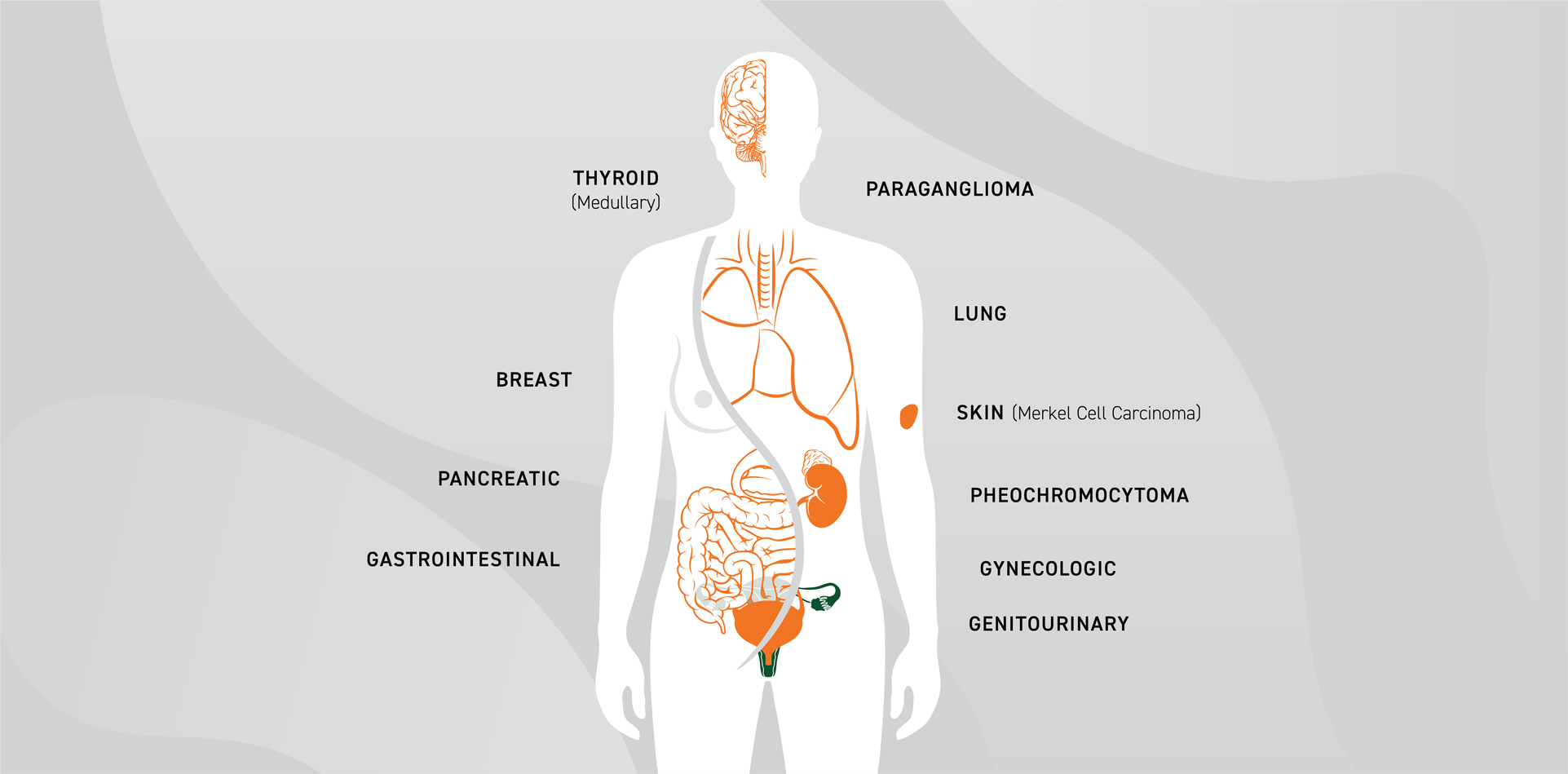When you hear hoofbeats, most people think of horses. It's the most obvious answer. Unfortunately, in the medical world, not all diagnoses are horses or the most likely possibility. Sometimes physicians need to look for the zebra — the less likely scenario when making a diagnosis. In the cancer world, neuroendocrine neoplasms are the zebras.
Neuroendocrine Neoplasms, or NENs, are a rare type of cancer that comes from neuroendocrine cells. Neuroendocrine cells receive signals from the nervous system and respond by making and releasing hormones into the bloodstream. These hormones help the body regulate functions like blood pressure, heart rate, digestion, breathing, and blood sugar levels.
A NEN forms when one of these cells mutates and starts multiplying, creating a tumor. While some NENs grow slowly, others can be fast-growing.
Although the rates of most common cancers have stabilized during the past 40 years in the United States, the occurrence of NENs has increased six to seven times during the same period. More than 170,000 people are currently living with a neuroendocrine neoplasm, according to Cancer.net.
Neuroendocrine Neoplasms: What to Know
Types of NENs
Neuroendocrine neoplasm is used as an umbrella term to encompass all neuroendocrine cancers. Then depending on how slow or fast the cells grow they are called neuroendocrine tumors (NETs) or neuroendocrine carcinomas (NECs). Regardless of their growth rate, all NENs are cancerous (malignant).
Neuroendocrine Tumors (NETs) are typically slower growing and are considered well-differentiated. Well-differentiated means the cells look more like healthy cells than cancerous cells. Previously NETs were called carcinoid tumors or carcinoid cancer.
NETs are classified by whether they produce hormones or not.
- Functional NETs produce excess amounts of the hormones the original cell made and can cause the patient to have symptoms.
- Non-functional NETs do not produce enough hormones to cause symptoms, making diagnosing them more difficult.
In addition to the hormone function of the tumor, doctors will assign a grade to your tumor. Grading describes how fast the tumor cells grow. NETs are divided into three grades:
- Grade 1 (low grade) — slow growth.
- Grade 2 (intermediate grade) — intermediate growth.
- Grade 3 (high grade) — fast growth.
Neuroendocrine Carcinomas (NECs) are fast-growing and are usually poorly differentiated. Poorly differentiated means the cells look more like cancerous cells than healthy cells. Poorly differentiated can be divided even further into small cell and large cell.
NECs are always grade 3 (high-grade) but can be well-differentiated.
NENs can develop anywhere in the body but are most commonly found in the gastrointestinal tract (digestive system), lungs, and pancreas. The location of the NEN helps determine the treatment plan and prognosis.

Diagnosis
Low-grade neuroendocrine tumors (NETs) can be challenging to diagnose because they often grow slowly and only cause symptoms once they are advanced. However, some NETs can produce hormones that cause various symptoms, such as flushing, diarrhea, and wheezing. This is also referred to as carcinoid syndrome. Not everyone with a NET develops carcinoid syndrome but it is most common in patients with NETs starting in the small bowel.
Neuroendocrine carcinomas (NECs) typically present with symptoms from the rapid growth of the cancer in the body leading the patient to seek care.
The following tests may be used to diagnose Neuroendocrine neoplasms (NENs):
- Blood and urine tests: These tests can look for elevated levels of hormones or other substances produced by NETs.
- Imaging tests: Imaging tests such as CT, MRI, and PET scans can be used to locate NENs and determine their size and spread.
- Biopsy: A biopsy is the removal of a small sample of tissue for examination under a microscope. This is the only definitive way to diagnose a NEN.
Staging
After being diagnosed with a neuroendocrine neoplasm, the next important step is to determine the stage of the tumor. Effective treatment plans require accurate staging.
Generally, staging refers to the tumor’s location, if and where it has spread, and whether other body parts are affected. The higher the stage, the more advanced the cancer. There may be slight differences in staging based on the tumor's location.
- Stage 1 — Cancer is present but has not spread beyond the origin site. This is also called early-stage cancer.
- Stage 2 — Cancer is present and may have grown. It has not spread to the lymph nodes or other parts of the body.
- Stage 3 — Cancer may have spread to nearby lymph nodes but has not spread to distant parts of the body.
- Stage 4 — Cancer has spread to distant parts of the body. This is called advanced or metastatic cancer.
Stage 4 cancer is not always terminal but usually cannot be cured. Patients may need more aggressive treatment options to prolong their life and improve their quality of life.
Dedicated Multidisciplinary Neuroendocrine Tumor Board
Our dedicated multidisciplinary neuroendocrine tumor board brings together specialists from various fields, including medical oncology, surgical oncology, radiology, pathology, and more. These experts review the patient’s chart, discuss treatment options, and develop a plan for the next steps. This collaborative team approach ensures that patients receive a comprehensive evaluation and benefit from diverse perspectives in developing their treatment plans.
Here's How it Works:
Diagnosis
Dedicated Multidisciplinary Tumor Board
Personalized Treatment Plan
Treatment Begins
Treatment
The treatment for Neuroendocrine neoplasms (NENs) depends on several factors, including the type and location of the tumor, its grade (how aggressive it is), and whether it has spread.
The following treatment options may be used for NENs:
- Surgery: Surgery removes the tumor as well as some of the healthy surrounding tissue. If the surgeon cannot remove the tumor completely, they will remove as much of it as possible. Surgery is the primary treatment for localized NETs.
- Somatostatin analogues (SSAs): SSAs are medications that bind to somatostatin receptors (SSTR) on neuroendocrine tumor cells and can help to slow tumor growth and relieve symptoms. These are given as an injection into the muscle.
- Chemotherapy: Chemotherapy uses strong drugs to kill the tumor cells. Chemotherapy is usually recommended for advanced tumors that cannot be removed with surgery. It can be used alone or in combination with other treatments. A patient may take these medications intravenously (through the vein using a needle) or in a pill or capsule form.
- Immunotherapy: Immunotherapy, also known as biological therapy, is a treatment that uses substances to activate or suppress a person's own immune system to fight cancer.
- Targeted drug therapy: Targeted drug therapy is a type of cancer treatment that uses drugs or other substances to precisely identify and attack certain types of cancer cells. Targeted drug therapy is often combined with chemotherapy for advanced tumors.
- Peptide receptor radionuclide therapy (PRRT): PRRT is a highly targeted and effective form of radiopharmaceutical therapy with minimal side effects. This radiopharmaceutical releases throughout the body but attaches onto the SSTR and only radiate the tumor. This therapy is given intravenously.
- Radiation therapy: Radiation therapy uses high-energy X-rays to destroy tumor cells. External-beam radiation therapy is the most common type of radiation treatment for neuroendocrine tumors.
The Role of Theranostics
Diagnosing and treating neuroendocrine neoplasms (NENs) can be a complex process. However, the Sylvester team has expertise in an innovative approach known as theranostics, which significantly refines this process.
Theranostics, also known as theragnostics, is a combination of the terms Therapeutics and diagnostics. It can be used to treat a variety of cancers, including neuroendocrine neoplasms. Theranostics is a personalized medicine technique that combines diagnosis and treatment with the use of radiotracers. Radiotracers are compounds made of radiation and chemicals that are injected into the bloodstream and selectively bind to a specific target in the body. One radiotracer used with a PET scan to identify or diagnose the cancer and a second radiotracer that selectively targets the tumor cells while avoiding healthy areas.
Clinical Trials and Research
Sylvester is a hub for groundbreaking research and actively participates in clinical trials.
Recent trials have explored the synergy of combining established therapies with emerging treatments, aiming to increase their effectiveness while minimizing side effects. Innovations in drug formulations and delivery methods are also being studied, seeking to optimize therapeutic agents' bioavailability (the amount of the medication that enters the bloodstream and can start working) and targeting capability (how well it can target the cancer specifically).
The department is also exploring the potential of peptide receptor radionuclide therapy (PRRT) and other targeted treatments in medical therapy. These innovations hold the promise of delivering highly specific treatment to tumor cells, minimizing exposure to non-cancer cells and associated side effects.
Here are some key points about Sylvester's role in clinical trials:
- Cutting-Edge Protocols: Sylvester is often among the first to employ new treatment methods under investigation, offering patients potential alternatives to traditional therapies.
- Multi-Centric Collaboration: The center works in partnership with national and international research organizations, enabling a collaborative approach to medical breakthroughs.
- Patient-Centric Approach: Clinical trials at Sylvester are designed with the patient’s safety and well-being in mind. Rigorous ethical standards are upheld, and patients are closely monitored for any adverse effects.
- Translational Research: Sylvester's research often bridges the gap between laboratory discoveries and patient care, turning scientific insights into actionable treatments.
- Access to a Range of Trials: The center offers Phase I to Phase IV clinical trials, exploring everything from early-stage investigational treatments to post-market surveillance studies.
- Individualized Trial Matching: After a thorough assessment, patients may be matched with a clinical trial that specifically aligns with the characteristics of their neuroendocrine cancer, thereby maximizing the potential for effective treatment.
Through its dedicated clinical trials program, Sylvester Comprehensive Cancer Center is not just treating NENs based on existing medical knowledge, but actively contributing to the expansion of that knowledge. This allows Sylvester to remain at the forefront of innovations in NEN management, offering hope and novel treatment options to its patients.
Why Choose Sylvester Comprehensive Cancer Center?
Sylvester Comprehensive Cancer Center offers a dedicated Neuroendocrine Tumor Program, emphasizing research and treatment of these complex cancers, under the leadership of Dr. Aman Chauhan. We are committed to bringing cutting edge and innovative treatment options to the patients of south Florida. How does Sylvester stand out?
NCI-Designation: Sylvester's recognition by the National Cancer Institute underscores its excellence in cancer care and research, providing an edge in NETs management.
Dedicated NETs Program: Spearheaded by Dr. Aman Chauhan, the program focuses on advancing NENs treatment and research, catering to the specific needs of NENs patients.
Clinical Trials Innovation: With ongoing trials exploring novel treatments, Sylvester is a hub for pioneering NENs research, offering patients access to groundbreaking therapies.
High-volume experience with neuroendocrine cancers. We have patients from all over the United States and other countries with varying stages and grades of neuroendocrine cancers, so we have the expertise to provide better outcomes with fewer potential complications.
Theranostic Expertise: Sylvester's approach integrates diagnosis and treatment, utilizing theranostics to tailor precise treatment plans for NETs, enhancing therapeutic effectiveness.
Advanced Diagnostics: Employing modern diagnostic tools such as PET/CT scans and hormone level assessments, Sylvester ensures accurate identification and staging of NETs, forming the bedrock for effective treatment strategies.
Multidisciplinary Expertise: A team of seasoned professionals collaborates to deliver a comprehensive, personalized treatment plan, ensuring optimal care for every NET patient.
Minimally invasive NanoKnife® radiosurgery. We provide more treatment options for patients with inoperable or difficult-to-reach tumors, producing little pain and requiring only a brief hospital stay.
Advanced radiation therapy options, like proton therapy, ViewRay (one of just five centers nationwide), and RapidArc®, offer intensity-modulated external radiation therapy (IMRT). Our leading-edge technology provides shorter treatment times, pinpoint accuracy in tumor targeting, and less damage to surrounding healthy tissue.
Questions? We're here to help.
Our appointment specialists are ready to help you find what you need. Contact us today.
